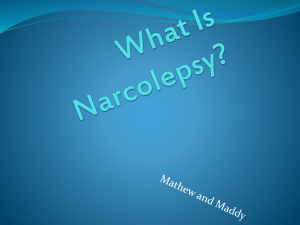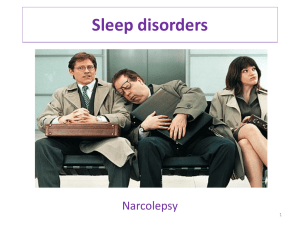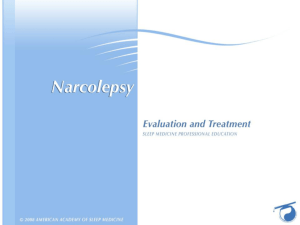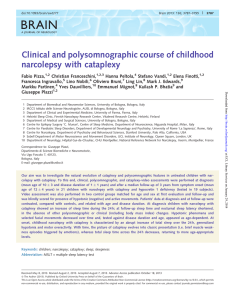HYPERTHYROIDISM Hyperthyroidism (overactive thyroid) is a
advertisement
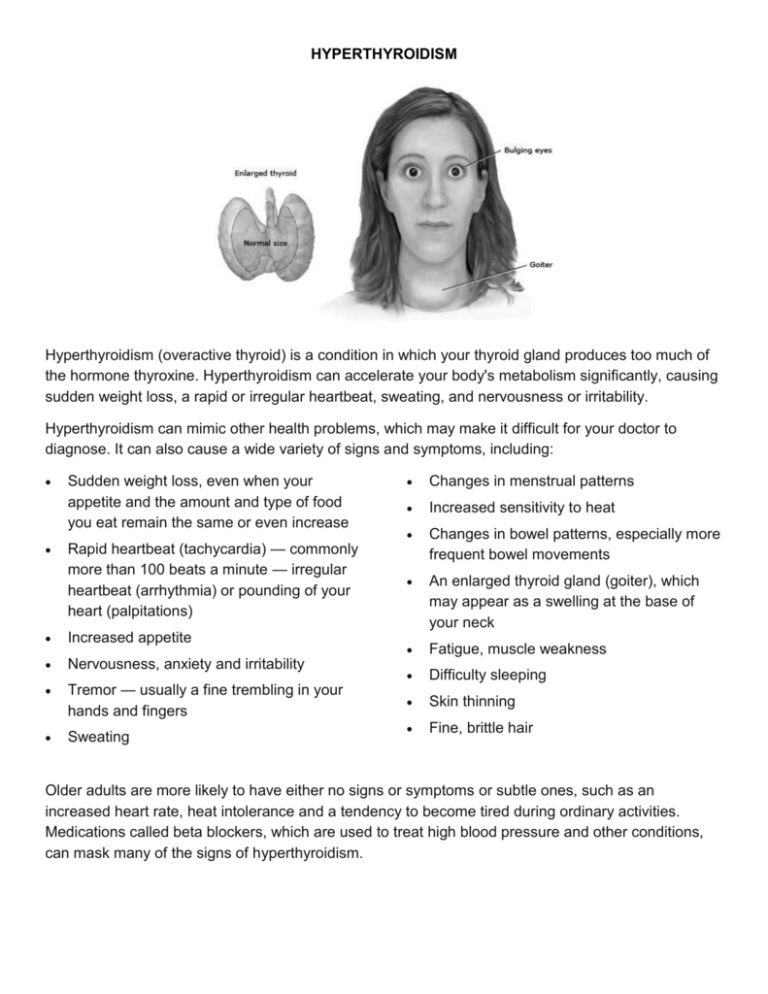
HYPERTHYROIDISM Hyperthyroidism (overactive thyroid) is a condition in which your thyroid gland produces too much of the hormone thyroxine. Hyperthyroidism can accelerate your body's metabolism significantly, causing sudden weight loss, a rapid or irregular heartbeat, sweating, and nervousness or irritability. Hyperthyroidism can mimic other health problems, which may make it difficult for your doctor to diagnose. It can also cause a wide variety of signs and symptoms, including: Sudden weight loss, even when your appetite and the amount and type of food you eat remain the same or even increase Rapid heartbeat (tachycardia) — commonly more than 100 beats a minute — irregular heartbeat (arrhythmia) or pounding of your heart (palpitations) Increased appetite Nervousness, anxiety and irritability Tremor — usually a fine trembling in your hands and fingers Sweating Changes in menstrual patterns Increased sensitivity to heat Changes in bowel patterns, especially more frequent bowel movements An enlarged thyroid gland (goiter), which may appear as a swelling at the base of your neck Fatigue, muscle weakness Difficulty sleeping Skin thinning Fine, brittle hair Older adults are more likely to have either no signs or symptoms or subtle ones, such as an increased heart rate, heat intolerance and a tendency to become tired during ordinary activities. Medications called beta blockers, which are used to treat high blood pressure and other conditions, can mask many of the signs of hyperthyroidism. ACROMEGALY Acromegaly is a hormonal disorder that develops when your pituitary gland produces too much growth hormone during adulthood. When this happens, your bones increase in size, including those of your hands, feet and face. Acromegaly usually affects middle-aged adults. In children who are still growing, too much growth hormone can cause a condition called gigantism. These children have exaggerated bone growth and an abnormal increase in height. Because acromegaly is uncommon and physical changes occur gradually, the condition often isn't recognized immediately; sometimes not for years. If not treated promptly, acromegaly can lead to serious illness and even become lifethreatening. However, available treatments for acromegaly can reduce your risk of complications and significantly improve your symptoms, including the enlargement of your features. One of the most common signs of acromegaly is enlarged hands and feet. People with this disorder often notice that they can no longer put on rings that used to fit and that their shoe size has progressively increased. Acromegaly may also cause you to experience gradual changes in the shape of your face, such as a protruding lower jaw and brow, an enlarged nose, thickened lips, and wider spacing between your teeth. Because acromegaly tends to progress slowly, early signs may not be readily apparent for several years. Sometimes, people notice the condition only by comparing old photographs. Acromegaly may produce the following signs and symptoms, which can vary from one person to another: Enlarged hands and feet Impaired vision Coarsened, enlarged facial features Headaches Coarse, oily, thickened skin Enlarged tongue Excessive sweating and body odor Pain and limited joint mobility Small outgrowths of skin tissue (skin tags) Menstrual cycle irregularities in women Fatigue and muscle weakness Erectile dysfunction in men A deepened, husky voice due to enlarged vocal cords and sinuses Enlarged liver, heart, kidneys, spleen and other organs Severe snoring due to obstruction of the upper airway Increased chest size (barrel chest) NARCOLEPSY The symptoms of narcolepsy most commonly begin between the ages of 10 and 25. They may worsen for the first few years, and then continue for life. They include: Excessive daytime sleepiness. People with narcolepsy fall asleep without warning, anywhere, anytime. For example, you may suddenly nod off while working or talking with friends. You may sleep for a few minutes or up to a half-hour before awakening and feeling refreshed, but eventually you fall asleep again. You also may experience decreased alertness throughout the day. Excessive daytime sleepiness usually is the first symptom to appear and is often the most troublesome, making it difficult for you to concentrate and fully function. Sudden loss of muscle tone. This condition, called cataplexy (KAT-uh-plek-see), can cause a number of physical changes, from slurred speech to complete weakness of most muscles, and may last for a few seconds to a few minutes. Cataplexy is uncontrollable and is triggered by intense emotions, usually positive ones such as laughter or excitement, but sometimes fear, surprise or anger. For example, your head may droop uncontrollably or your knees may suddenly buckle when you laugh. Some people with narcolepsy experience only one or two episodes of cataplexy a year, while others have numerous episodes daily. Not everyone with narcolepsy experiences cataplexy. Sleep paralysis. People with narcolepsy often experience a temporary inability to move or speak while falling asleep or upon waking. These episodes are usually brief — lasting one or two minutes — but can be frightening. You may be aware of the condition and have no difficulty recalling it afterward, even if you had no control over what was happening to you. This sleep paralysis mimics the type of temporary paralysis that normally occurs during rapid eye movement (REM) sleep, the period of sleep during which most dreaming occurs. This temporary immobility during REM sleep may prevent your body from acting out dream activity. Not everyone with sleep paralysis has narcolepsy, however. Many people without narcolepsy experience some episodes of sleep paralysis, especially in young adulthood. Hallucinations. These hallucinations are called hypnagogic hallucinations if occurring as you fall asleep and hypnopompic hallucinations if occurring upon waking. Because you may be semiawake when you begin dreaming, you experience your dreams as reality, and they may be particularly vivid and frightening Normal sleep pattern vs. narcolepsy The normal process of falling asleep begins with a phase called non-rapid eye movement (NREM) sleep. During this phase, your brain waves slow considerably. After an hour or so of NREM sleep, your brain activity changes, and REM sleep begins. Most dreaming occurs during REM sleep. In narcolepsy, however, you may suddenly enter into REM sleep without first experiencing NREM sleep, both at night and during the day. Some of the characteristics of REM sleep, such as sudden lack of muscle tone, sleep paralysis and vivid dreams, occur during other sleep stages in people with narcolepsy. The role of brain chemicals Hypocretin (hi-po-KREE-tin) is an important chemical in your brain that helps regulate wakefulness and REM sleep. People with narcolepsy have low levels of this neurochemical in their spinal fluid. It's particularly low in those who experience cataplexy. Exactly what causes the loss of hypocretinproducing cells in the brain isn't known, but experts suspect it's due to an autoimmune reaction. DIABETES Diabetes mellitus refers to a group of diseases that affect how your body uses blood sugar (glucose). Glucose is vital to your health because it's an important source of energy for the cells that make up your muscles and tissues. It's also your brain's main source of fuel. If you have diabetes, no matter what type, it means you have too much glucose in your blood, although the causes may differ. Too much glucose can lead to serious health problems. Chronic diabetes conditions include type 1 diabetes and type 2 diabetes. Potentially reversible diabetes conditions include prediabetes — when your blood sugar levels are higher than normal, but not high enough to be classified as diabetes — and gestational diabetes, which occurs during pregnancy but may resolve after the baby is delivered. Diabetes symptoms vary depending on how much your blood sugar is elevated. Some people, especially those with prediabetes or type 2 diabetes, may not experience symptoms initially. In type 1 diabetes, symptoms tend to come on quickly and be more severe. Some of the signs and symptoms of type 1 and type 2 diabetes are: Increased thirst Frequent urination Extreme hunger Unexplained weight loss Presence of ketones in the urine (ketones are a byproduct of the breakdown of muscle and fat that happens when there's not enough available insulin) Fatigue Irritability Blurred vision Slow-healing sores Frequent infections, such as gums or skin infections and vaginal infections ADDISON’S DISEASE Addison's disease is a disorder that occurs when your body produces insufficient amounts of certain hormones produced by your adrenal glands. In Addison's disease, your adrenal glands produce too little cortisol and often insufficient levels of aldosterone as well. Also called adrenal insufficiency, Addison's disease occurs in all age groups and affects both sexes. Addison's disease can be life-threatening. Treatment for Addison's disease involves taking hormones to replace the insufficient amounts being made by your adrenal glands, in order to mimic the beneficial effects produced by your naturally made hormones. Addison's disease symptoms usually develop slowly, often over several months, and may include: Muscle weakness and fatigue Weight loss and decreased appetite Darkening of your skin (hyperpigmentation) Low blood pressure, even fainting Salt craving Low blood sugar (hypoglycemia) Pain in your lower back, abdomen or legs Nausea, diarrhea or vomiting Muscle or joint pains Severe vomiting and diarrhea, leading to dehydration Irritability Low blood pressure Depression Loss of consciousness Body hair loss or sexual dysfunction in women High potassium (hyperkalemia) Acute adrenal failure (addisonian crisis) Sometimes, however, the signs and symptoms of Addison's disease may appear suddenly. In acute adrenal failure (addisonian crisis), the signs and symptoms may also include:
